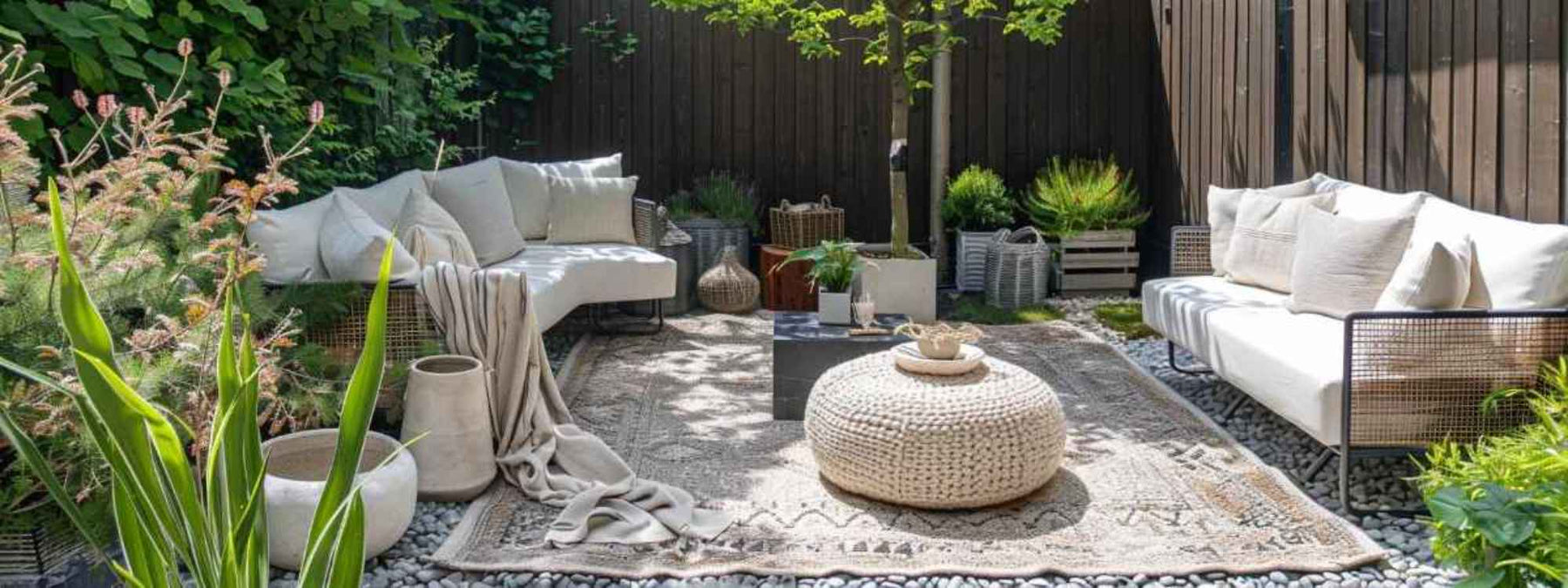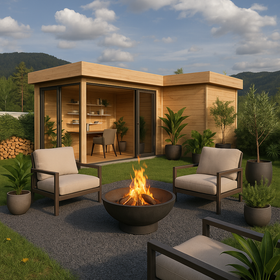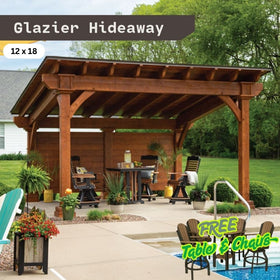512-777-0154

How to Weatherproof Your Outdoor Space (Without Breaking the Bank)
So, you’ve finally carved out that perfect outdoor space. A few comfy chairs. Maybe a string of lights. The kind of spot that makes you want to kick back and stay a while.
But then… the weather hits.
The cushions are soggy. The umbrella’s flipped inside out. And that cute outdoor rug? Faded into something that barely resembles its original color.
Sound familiar?
It’s one of those annoying truths. If you want your outdoor patio space to last, you’ve got to protect it. But here’s the good news: weatherproofing doesn’t have to be expensive. You don’t need to shell out thousands or hire a pro.
With a few smart tweaks, you can keep your space looking good—without draining your wallet. And once it’s weatherproofed? You’ll spend less time worrying about damage and more time enjoying it.
Start by Spotting the Weak Spots: Where’s the Weather Sneaking In?
Before you can protect your outdoor space, you need to know where it’s taking a hit.
Start by walking around. Slowly. Look at everything like it’s the first time.
Are there water stains near the base of a wall? Rust on the bottom of that metal chair? Faded fabric on one side of your cushions but not the other? That’s the sun doing its thing.
Maybe water’s pooling in one corner after it rains. Or wind is sneaking through a gap in the fence you thought was solid.

You’re not overthinking. These are the exact signs to look for.
The sooner you catch them, the cheaper the fix. That’s the goal—less damage, less repair, more time enjoying your outdoor space.
Think of it like a quick health check. You’re not tearing anything apart. Just spotting the early signs before they turn into bigger (and more expensive) problems.
Once you know what you’re dealing with, the rest gets easier.
5 Smart Ways to Weatherproof Your Outdoor Space
You don’t need a construction crew or a stack of cash to keep your outdoor space safe from the elements. These five fixes are affordable, simple, and surprisingly effective.
1. Seal It Up with Weather-Resistant Caulk
This one sounds boring. But it works.
Tiny cracks and gaps in your LuxCraft Horizon Furniture Set are where water loves to sneak in. Over time, that moisture leads to rot, rust, and other problems that cost more to fix.
A tube of exterior-grade caulk costs less than a takeout lunch. Use it to seal around door frames, fence posts, trim edges, or any place where water might pool or leak through.
You don’t need to be handy. Just clean the area first, apply the bead slowly, and smooth it out with your finger or a plastic spoon.
2. Swap Out Cushions for Waterproof Covers (Or Make Your Own)
Outdoor cushions look great—until they’re soaked, smelly, or bleached by the sun.
Waterproof covers are a simple upgrade. They block moisture, resist mildew, and keep colors from fading too fast. If new covers aren’t in the budget, spray-on waterproof fabric sealants can help, too.
Even a tarp works in a pinch, especially during rainy weeks.
Bonus: a little protection keeps the cushions from turning that weird greenish-gray shade no one wants to sit on.
3. Create Shade Without Breaking the Bank
The sun is just as sneaky as rain when it comes to damage. It fades outdoor furniture, warps wood, and makes your space too hot to use.
The fix doesn’t have to be fancy. Shade sails, outdoor curtains, or even a stretched canvas sheet between two posts can cool things down fast.
You might already have what you need—an old umbrella base, a bit of fabric, or hooks on the fence.
No need to go full designer mode. But if you have the budget, why not install Brookside Timber Frame Forest Melody Pavilion?
4. Get Smart with Flooring: Outdoor Rugs and Drain Mats
Rain doesn’t just fall. It collects. And when it collects on wood or concrete, you get slippery spots, splinters, and slow damage.
Outdoor rugs made from plastic or recycled materials drain quickly and dry fast. They’re cheap, colorful, and easy to roll up and clean.
For high-traffic areas, consider rubber drain mats. Not the prettiest solution, but they’re practical—especially near doors or grilling zones.
It’s an easy way to protect the floor without sealing the whole deck.
5. Store (or Hide) the Stuff That Won’t Survive the Storm
You don’t have to weatherproof everything. Just put the delicate stuff away.
A waterproof storage bin, a bench with a lid, or an old cabinet in a covered corner works fine. Doesn’t need to be fancy—just dry and out of the sun.
Cushions, blankets, candles, tabletop decor… all safer inside.
It’s the simplest fix on this list. Less stuff exposed = less stuff ruined.
Quick Wins You Can Tackle This Weekend
Not every fix needs a workshop or a full set of tools. Some jobs are quick, cheap, and easy enough to knock out in an afternoon.
Start with your cushions. A few coats of waterproofing spray can help them fight off rain and stains. Let them dry, and they’re ready to handle the next downpour.

Look at where your furniture, like the LuxCraft 4' Plain Glider, sits. If something’s getting blasted by wind or baked by the sun, move it to a better spot. Sometimes a few feet makes a big difference.
Got an open corner? Try installing a tension rod and hanging outdoor curtains. It’s a fast way to block the sun or wind without drilling holes.
And if you’ve spotted cracks in the patio? Give them a quick clean and seal. You don’t need fancy gear—just a tube of sealant and a steady hand.
None of these projects need pro skills. You won’t need a giant toolbox either. Just a few hours and a little patience.
When to Spend (and When to Skip): Budget Priorities That Pay Off
Not every outdoor upgrade deserves your money. Knowing what’s worth a bit extra—and what’s not—makes all the difference.
If you’re thinking of investing, start with storage. A waterproof storage bench isn’t just storage—it’s furniture that keeps your stuff dry. It looks good, protects your gear, and saves you money replacing damaged cushions.
The same goes for shade. A UV-protective shade cover can feel pricey at first. But furniture that doesn’t fade, crack, or warp in the sun saves you cash in the long run.
On the flip side, skip those designer outdoor rugs. They look great in photos, but cheaper options do the same job and last just as long. They’re going to get dirty anyway.
The same goes for expensive cushion covers from high-end brands. Affordable, waterproof covers or sprays do the trick without breaking the bank.
How to Maintain Your Weatherproof Setup Without Stress
Weatherproofing your outdoor space doesn’t mean constant upkeep. You’ve done the hard part. Now, just a little routine care keeps things running smoothly.
Here’s a quick checklist to keep it simple:
- Check your caulk lines once a year. Look for peeling or cracks. Touch them up, and you're set for another year.
- Clean covers and cushions regularly. Dust, pollen, and grime build up. A quick hose-down or gentle scrub keeps mold and stains away.
- Rinse rugs and mats after heavy storms. Debris and mud left too long can shorten their lifespan. A few minutes spent rinsing saves money later.
You don’t need an extensive routine or complicated tools. Just small steps to protect your investments and keep your outdoor space inviting.
A bit of maintenance now and then means fewer headaches later
Weatherproofing Doesn’t Have to Feel Like a Chore (or Cost a Fortune)
Protecting your outdoor space doesn’t have to be a big project—or a big expense.
A few small steps can go a long way. Seal up the gaps. Cover what needs covering. Move things around when the weather shifts. None of it has to be perfect.
The goal isn’t to make your space bulletproof. It’s to make it last a little longer. To keep it comfortable without replacing things every season. And to spend less time worrying about what the weather might do next.
When you break it down, weatherproofing is really about getting ahead of the damage. And once it’s done, you’re free to enjoy your patio space, not just maintain it.
If you’re looking for more ideas to make outdoor living easier, stick around. We’ve got more simple, practical guides to help you get the most out of your space.






